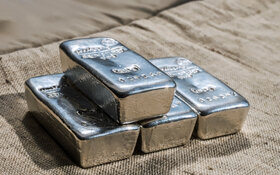Mike Kachanovsky: We are in a double-dip recession. A lot of market commentators still feel that we can avoid that, but I think we're right in the middle of it. I am still bullish on the junior mining stocks for the reason that, unlike most other business models, mining companies have stronger fundamentals down the road. Most of these juniors that have commenced production are making money now and their outlook is to make even more money going forward. I like the junior resource stocks and I tend to shun the more conventional sectors for investors.
TGR: Investors exited precious metal juniors en masse in early August when U.S. politicians couldn't reach a deal on the debt ceiling. Gold then spiked, but has since trended lower. Do you believe traders are looking for the gold price to find a bottom before they return to the market?
MK: I think that's a good statement. The typical investors that I talk to believe that precious metals and gold are too high, that they missed the run, and they're expecting a lot lower price levels before they consider buying in. That's very bullish. That's a contrarian indicator.
Most of the time that sort of analysis has been flawed and the people who were holding off on buying and hoping for lower levels to buy at were left behind. I don't think it is any different this time around. I think the gold price will go above $2,000/ounce (oz.) and silver will move above $50/oz. before the end of this year.
The fact that so many investors are standing on the sidelines suggests that there is less downside ahead and that a lot of the buying power will start chasing the metals higher once we get some sort of a recovery and a sustained rally.
TGR: Any idea of the timeframe of when that might happen?
MK: The biggest mistake that any amateur analyst can make is to try and pin a time on when a correction is coming or when a new high is coming. It is such a volatile sector. I think the more rational approach is just to buy the dip. It is a volatile commodity. There are triple-digit moves happening on a regular basis in gold. When I see that gold has been hammered for three or four days in a row and it is at a low, I'll pick up the phone and buy more. In fact, I did just that on Friday and bought more gold and more silver.
TGR: Was that bullion or equities?
MK: I buy and sell equities and I buy bullion and accumulate it. I have actually never sold an ounce of gold or silver, but I've been a buyer steadily for the last eight years in both metals.
TGR: The gold price is trading primarily on fear right now. We can see daily swings of $20–$80/oz. When do you think the hyperinflation trade will kick in?
MK: All the major currencies in the world are in a race to the bottom. The events of hyperinflation in the last hundred years usually involved one weak currency, while most other nations were showing strength. In those cases, it was very easy for inflation to manifest itself in places like Germany's Weimar Republic and Zimbabwe. We are not seeing that because it is affecting almost every nation worldwide. However, because gold, and to a lesser extent silver, are rising so strongly in this environment, that indicates that it is already underway. Gold is the asset of last resort that people are turning to. When you start having a lot of people in a lot of countries around the world all acting at the same time, that is when I think we start having to be concerned that a hyperinflation environment is starting to kick in.
TGR: The London Bullion Market Association (LBMA) said almost 11 billion ounces of gold traded in the first quarter of 2011, which is far more gold than has ever been produced from all mining combined on the planet. Does that make you somewhat wary about some of the gold derivatives being offered out there?
MK: That statistic is probably the most important fact that all investors that are even considering precious metals should consider. The LBMA is just one market. You also have gold trading on the Comex. You have Over the Counter trades between private counterparties. Shanghai just opened a bullion market. Collectively, the amount of gold that trades in any given day is a multiple of the real gold that is out there.
As a trading vehicle, there are all kinds of exchange-traded funds and paper products, but if you want leverage to actual bullion, there is no substitute for buying the real thing and having it in your control and custody. There are all these paper and derivative products that are leveraged to it. I think that is unstable and a lot of people are going to be left holding a toxic asset at the end of the day instead of the security that they thought they were getting leverage to by putting money into bullion.
TGR: You have said that you are buying equities as a way to get some leverage on the price for gold and silver. Are you sticking to precious metal producers or near-term producers with money in the bank as a way to mitigate risk in the current market?
MK: To get full leverage to the sector, you need to have diversity across the spectrum. My current strategy is to lean toward the companies that are currently in production. Both gold and silver have risen substantially. The companies that have the real leverage to that, the producers, are the ones that are going to benefit the most at this stage in the bull market. They are the ones that have the rising earnings and the stronger fundamentals for investors to focus on.
On the other hand, I like emerging stocks. They are trading at a very tight discount range relative to their historic multiples. Companies that have viable deposits that are funded and able to emerge as producing mines in the next year represent a compelling story. I still like exploration because the greatest gains that you can get in this sector come from buying a low-priced exploration story that hits on a big new discovery.
But that is also the riskiest part of the market. Investors need to be very selective and careful in choosing good projects, good management and companies with the money to continue with their exploration work.
The fear that we are seeing in the market right now is very short term and cyclical. An exploration story may take years to develop. I don't think investors should stay away from the explorers. They just need to be selective because during those bearish times it is difficult for companies to raise money and their stocks are probably going to be out of favor. Investors should find the companies that they can be comfortable holding and wait until they find new mineral discoveries and get rewarded with a higher share price.
TGR: What are some producers that fit that bill?
MK: I just returned from a trip to Montana to see Revett Minerals Inc. (RVM:TSX; RVM:NYSE.A). I was floored. I was impressed at every stage of this operation. The company is a silver and copper producer, so it has leverage to base and precious metals. Its balance sheet is strong. Its mine is absolutely superb. Its mineral inventory is growing. Environmentally, Revett is a textbook operation in how to run a clean, efficient mine. The stock price is trading at a value range right now. I started accumulating the stock just in the last couple of weeks. I think it has a bright future.
This is exactly the kind of company that I am looking for to provide safety in my current investment, provide upside for the future, and have full leverage to what I believe is a long-term bull market for the metals.
TGR: The company also has another more robust project called Rock Creek. However, Revett's involved with litigation regarding that project in a district court. A ruling is not far away. If Revett were to get a favorable ruling on Rock Creek, it could materially change the stock price in a hurry.
MK: I agree. I think Revett has done everything right. It is starting to win over some of the environmental groups because of the attention to environmental stewardship that the company demonstrated in its current operation. It has proven that it can run a mine that has very minimal disruption to the surrounding wilderness and community.
At the same time, Revett brings in great benefits to a part of the world that doesn't have a lot of economic opportunity or high paying jobs. My feeling is that the company will be successful in getting permitting for Rock Creek. However, I minimize the impact on the actual operating results of the company because even if it had approval today and it was able to commence development, it is a very large project and it is probably at least two years down the road before it would see any operating return. Whereas the current Troy Mine has a world-class resource that could still be producing in 20 or 30 years.
It is nice to have an even better prospect to look forward to, but I think it is compelling just on its current upside potential.
TGR: Let's talk about some near-term producers.
MK: There's a stock that I like in the rare earth segment called Pacific Wildcat Resources Corp. (PAW:TSX.V), which has two projects active in Africa. The company's tantalum mine, which is an exotic metal, is in production. It also has a rare earth and niobium project. If Pacific Wildcat can get one of these rare earth element mines into production, it has the potential to generate near-term cash flow from just niobium and tantalum.
Pacific Wildcat is a very risky stock. A lot of moving parts could create delays. But, on the other hand, it is priced at a very reasonable level. It has strong upside if the management team is able to advance these projects to a point where it achieves full production and has leverage to the high metal prices in those resources. Don't bet the farm and put granny's retirement money on the line, but a small investment in a company like this could easily turn into a very large winner.
TGR: Any other near-termers?
MK: One that I like is Avino Silver & Gold Mines Ltd. (ASM:TSX.V; SGMF:OTCBB) in Mexico. The company has been active on this project for 20 years. It was in production in the 1990s. The company just got this thing going again in the last year and it is making money. It plans to expand capacity and continue with production.
Avino has strong management, a very strong balance sheet, a good resource, current infrastructure in place, it's profitable, and it provides investors with full leverage to gold, silver and base metals. It's a good near-term emerging producer that I can put into my portfolio, hold for a year or two, and probably see the stock rise substantially. But there may be ups and downs and swings of sentiment that are going to be a test of commitment along the way.
One other emerging producer that is worth a look is Scorpio Gold Corp. (SGN:TSX.V) I think Nevada is a great place to build a mining company and Mineral Ridge Mine looks like it can generate strong cash flow with gold above $1,500/oz. I expect to see a nice growth curve as the company expands production and improves the overall operating efficiency of the project; plus I think there is a good chance that further exploration will expand the resource and extend the mine life. The stock has plenty of upside potential if the company can achieve its production targets for next year.
TGR: What about exploration plays?
MK: I am following quite a few good explorers right now. And when I say a "good" explorer, I mean they have the potential to find a world-class discovery. But a lot of these companies are early stage.
One explorer that I like is Galore Resources Inc. (GRI:TSX.V), which has a large-scale project in Mexico. It has been working on this project very patiently for about two years doing field work, defining structure and identifying the areas that could produce a world-class deposit.
Galore trades at a very tiny market cap. It has a chance to be one of those winners that can make a portfolio. It has got very competent management and a solid track record in advancing the early-stage exploration on its prospect. It has all the upside ingredients and you can still buy it very cheaply today, and sit and wait. It is like the prototypical lottery ticket junior explorer.
TGR: Galore also has a copper project in British Columbia. Where's the company at with that?
MK: I believe that Galore's real focus is in Mexico and it's just going to do enough work to maintain the copper story and hold it in good standing. It's not necessarily what the company is most excited about at this point in the cycle.
TGR: Galore just released some results on the property at El Alamo, which is part of the Dos Santos project. The best result was 12 meters of 0.96 grams gold. That's a very modest result, but it points to the fact that there is certainly gold in the area. What were your thoughts after hearing about those results?
MK: Typically, I'm not motivated by the grades that come from the early-stage field work. I want to see that the company is finding gold or whatever metals it has leveraged at surface and that the geology and the interpretation of the structure suggests that there could be a large volume of rock that has those types of grades. Most large deposits have zoning, so what is going on in one part of the story may be completely different from what is found as you go deeper.
A lot of companies will get investors excited because they'll do trenching and find really high-grade gold at the surface, but then they'll find out it doesn't go very far down and they can't replicate the same kind of intervals to depth. There has to be a lot more of that type of metal the further down you go. That's when you start getting excited.
Canplats is a great example of that with their Camino Rojo discovery in Mexico. Canplats was bought by Goldcorp Inc. (G:TSX; GG:NYSE) and so Camino Rojo is now a Goldcorp property that is very close to Galore's property. About three years prior to the big discovery, its stock wasn't going very far. It was very quiet and sedate. It was coming up with reasonable grades, but nothing exciting for a long time. Then, all of a sudden, it started to hit these broad intervals and the project accelerated.
TGR: What are some other interesting explorers?
MK: One that I really like in Québec is Eastmain Resources Inc. (ER:TSX), which has been active for more than 10 years. The company has been finding high-grade gold just about everywhere it goes, but it just recently announced a new discovery in a part of its deposit that had not been investigated.
Eastmain is finding high-grade gold across fairly wide intervals. It has evolved to become an open-pit gold mine prospect, whereas previously it was drilling deeper and finding more narrow vein high-grade gold. Now it has revaluated the entire prospect and figures that it can have an economic shot with a lower average grade, but in a large deposit that can be open-pit mined near surface.
That is why I'm starting to get excited about this story. A lot of other juniors have taken that same model in recent years and started looking at much lower grades that can be mined more cheaply in a window of $1,500–$2,000/oz. gold.
I like Eastmain because it has a strong track record of success. The company is located in a favorable mining jurisdiction. It is spending over $10 million this year alone in exploration. It's very well funded, so it can continue to carry a project forward. Plus, its market cap and share price are still very low relative to its peer group. Despite all these strong factors, Eastmain is still a cheap stock to buy with a big upside if it is successful.
TGR: Is there another out-of-favor name that you like?
MK: Commerce Resources Corp. (CCE:TSX.V; D7H:Fkft; CMRZF:OTCQX) is another rare element story. The rare element subsector tends to go through boom/bust cycles. Right now, we're on the bust side of it. Investors seem to get very excited every year or so about these stocks and then it fizzles and the stocks sell off again. It doesn't really reflect the fundamental strength of some of the companies within that subsector.
Commerce is a very strong company. It has been active in rare metals for more than a decade. It's not just a "flavor of the month" pick. It has two excellent projects in play, both of which are emerging as very large tonnage, relatively high-grade discovery areas. Commerce is actively advancing both projects to be able to support a development decision.
A project that I'm excited about is known as the Eldor property. It has several showings on that property for rare elements. I'm excited because it has enrichment zones in both the heavy rare earth elements and the light rare earth elements. That's very rare. Very few companies anywhere in the world have deposits that are enriched in both the heavy and the light.
Eldor is still fairly early stage, but having that higher grade and a high value is a huge advantage that can help even if some of the other development parameters come in marginal. Commerce fits my model of finding quality companies that are well financed with strong discovery potential, but trade well below the peer group for the sector.
TGR: Any final bits of investing wisdom for our readers?
MK: There are a lot of big changes going on in the world. I think "buy and hold" no longer works. The torch for economic leadership is in the process of passing from the developed Western nations to emerging countries and the Asian nations. It's a period of turmoil and change.
Based on the major stock indexes, investors haven't made any money in the past 10 years—in fact, they probably lost money. Many of the different asset classes are losing money. The one exception is bonds and fixed income, but I believe that's a bubble that's subject to popping. It's too late to buy those. The one exception to this is precious metals. They have outperformed every other asset class and it is the only legitimate candidate to be a buy-and-hold investor in.
I find it very ironic that the majority of the commentary in the mainstream is steering people away from the metals and suggesting perhaps that it's a bubble or that it's the wrong time to be a buyer. I have always approached the market as a contrarian. I feel most comfortable putting my money at risk where most other investors are not feeling bullish. I think there is a really good trend there and I am going to continue buying the mining stocks that have strong fundamentals with full leverage to the metals and ignoring what the majority of the so-called smart money has to say.
The mainstream commentary that has had anything to say about the precious metals sector over the last 10 years has been largely discredited. I would be very leery as in investor right now in participating in fixed income or bonds or buying the broader markets. But I do think everyone needs to have some exposure to precious metals and to be a long-term passive investor in these sectors. That's probably the way to have some sort of stability in this macro environment of dramatic change and volatility.
TGR: Thanks, Mike.
Mike Kachanovsky, known as "Mexico Mike," is a consultant providing analysis of junior mining and exploration stocks. His work is published on a freelance basis in a variety of publications, including the Mexico Mike column in Investor's Digest of Canada. Kachanovsky is a founder of the website www.smartinvestment.ca, which serves as an online community for the discussion of all topics relating to junior mining stocks.
Want to read more exclusive Gold Report interviews like this? Sign up for our free e-newsletter, and you'll learn when new articles have been published. To see a list of recent interviews with industry analysts and commentators, visit our Exclusive Interviews page.
DISCLOSURE:
1) Brian Sylvester of The Gold Report conducted this interview. He personally and/or his family own shares of the following companies mentioned in this interview: None.
2) The following companies mentioned in the interview are sponsors of The Gold Report: Galore Resources Inc., Goldcorp Inc., Commerce Resources Corp. and Scorpio Gold Corp.
3) Mike Kachanovsky: I personally and/or my family own shares of the following companies mentioned in this interview: None. I personally and/or my family am paid by the following companies mentioned in this interview: None.










































